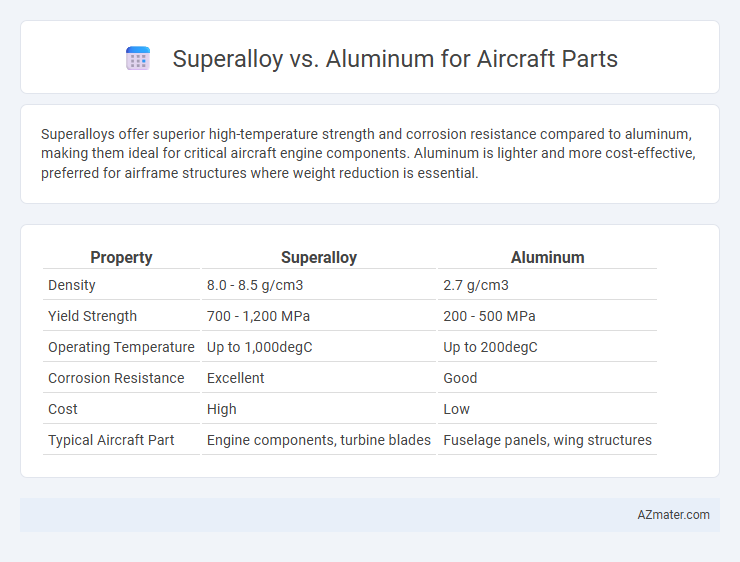Superalloys offer superior high-temperature strength and corrosion resistance compared to aluminum, making them ideal for critical aircraft engine components. Aluminum is lighter and more cost-effective, preferred for airframe structures where weight reduction is essential.
Table of Comparison
| Property | Superalloy | Aluminum |
|---|---|---|
| Density | 8.0 - 8.5 g/cm3 | 2.7 g/cm3 |
| Yield Strength | 700 - 1,200 MPa | 200 - 500 MPa |
| Operating Temperature | Up to 1,000degC | Up to 200degC |
| Corrosion Resistance | Excellent | Good |
| Cost | High | Low |
| Typical Aircraft Part | Engine components, turbine blades | Fuselage panels, wing structures |
Introduction to Aircraft Material Selection
Superalloys and aluminum are critical materials in aircraft part fabrication due to their distinct mechanical properties and performance under extreme conditions. Superalloys, known for exceptional high-temperature strength and corrosion resistance, are often selected for engine components and turbine blades. Aluminum alloys provide lightweight solutions with excellent machinability and corrosion resistance, making them ideal for airframe structures and components focused on weight reduction and fuel efficiency.
What Are Superalloys?
Superalloys are advanced metal alloys primarily composed of nickel, cobalt, or iron, engineered to maintain exceptional strength and resistance to high temperatures, corrosion, and oxidation, making them ideal for aircraft parts exposed to extreme environments. Unlike aluminum, which is lightweight and commonly used for general aircraft components, superalloys are crucial in critical areas such as turbine blades and engine components where thermal stability and mechanical strength are paramount. Their unique capacity to withstand harsh operating conditions ensures enhanced durability and performance in aerospace applications.
Overview of Aluminum in Aviation
Aluminum is widely used in aviation due to its high strength-to-weight ratio, excellent corrosion resistance, and ease of fabrication. It significantly reduces aircraft weight, improving fuel efficiency and performance while maintaining structural integrity. Common aluminum alloys like 2024 and 7075 are preferred for aircraft parts because they provide a balanced combination of strength, durability, and machinability.
Mechanical Properties Comparison
Superalloys exhibit superior mechanical properties such as high tensile strength, exceptional creep resistance, and excellent fatigue life, making them ideal for high-temperature aircraft parts like turbine blades. Aluminum alloys offer a favorable strength-to-weight ratio with good corrosion resistance and moderate tensile strength, suited for structural components where weight savings are crucial. The choice between superalloy and aluminum depends on the operating temperature and mechanical stress requirements, with superalloys excelling in extreme thermal environments and aluminum preferred for lightweight, lower-stress applications.
Weight and Density Differences
Superalloys exhibit significantly higher density, typically around 8.0 to 9.0 g/cm3, compared to aluminum's lower density of approximately 2.7 g/cm3, which directly impacts the overall weight of aircraft parts. The superior strength-to-weight ratio of aluminum makes it preferable for components where minimizing weight is critical, enhancing fuel efficiency and payload capacity. However, superalloys offer exceptional high-temperature strength and corrosion resistance, essential for engine parts despite their greater mass.
Corrosion Resistance in Aircraft Environments
Superalloys exhibit superior corrosion resistance compared to aluminum in harsh aircraft environments, particularly against high-temperature oxidation and saltwater exposure. Aluminum alloys, while lightweight and cost-effective, are more prone to galvanic corrosion and require protective coatings to enhance durability. The exceptional corrosion resistance of superalloys ensures longer service life and reduced maintenance for critical aircraft components exposed to aggressive operational conditions.
Heat Tolerance and Operating Temperatures
Superalloys exhibit superior heat tolerance compared to aluminum, maintaining structural integrity at temperatures up to 1,100degC, whereas aluminum alloys typically withstand operating temperatures only up to around 250degC. This thermal resilience makes superalloys ideal for critical aircraft parts exposed to extreme heat, such as turbine blades and engine components. Aluminum's lower melting point limits its use primarily to airframe structures where high thermal resistance is less critical.
Manufacturing and Machinability
Superalloys offer superior high-temperature strength and corrosion resistance, making them ideal for critical aircraft components that endure extreme conditions, yet they present challenges in manufacturing due to their hardness and tendency to cause rapid tool wear. Aluminum alloys provide excellent machinability and lightweight properties, enabling faster production cycles and easier fabrication for less stress-intensive parts. Choosing between superalloy and aluminum depends on balancing performance needs with manufacturing efficiency and tooling costs within aerospace production.
Cost Considerations and Lifecycle Analysis
Superalloys exhibit higher initial costs compared to aluminum due to complex manufacturing and raw material expenses but offer superior high-temperature strength and corrosion resistance, extending component lifespan. Aluminum, though more affordable upfront and lightweight, may require more frequent replacements or maintenance, increasing overall lifecycle costs in demanding aerospace environments. Lifecycle analysis often reveals that superalloys can provide cost efficiency over time by reducing downtime and enhancing durability despite their elevated initial investment.
Applications: Choosing the Right Material for Aircraft Parts
Superalloys are ideal for high-temperature engine components and turbine blades due to their exceptional strength, oxidation resistance, and thermal stability. Aluminum excels in airframe structures and interior components, offering lightweight properties and corrosion resistance that contribute to fuel efficiency. Selecting the right material depends on balancing performance requirements, operating conditions, and weight considerations critical to aircraft safety and efficiency.

Infographic: Superalloy vs Aluminum for Aircraft Part
 azmater.com
azmater.com